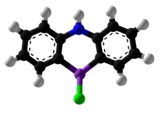This article needs additional citations for verification. (September 2007) |

| |||
| |||
| Names | |||
|---|---|---|---|
| Preferred IUPAC name
10-Chloro-5,10-dihydrophenazarsinine | |||
| Other names
10-Chloro-5H-phenarsazinine
Diphenylaminechlorarsine | |||
| Identifiers | |||
3D model (JSmol)
|
|||
| Abbreviations | DM | ||
| ChemSpider | |||
| ECHA InfoCard | 100.008.577 | ||
| EC Number |
| ||
| MeSH | Phenarsazine+chloride | ||
PubChem CID
|
|||
| UNII | |||
CompTox Dashboard (EPA)
|
|||
| |||
| |||
| Properties | |||
| C12H9AsClN | |||
| Molar mass | 277.58 g·mol−1 | ||
| Appearance | Yellow-green crystals | ||
| Melting point | 195 °C (383 °F; 468 K) | ||
| Boiling point | 410 °C (770 °F; 683 K) | ||
| 0.064 g dm−3 | |||
Except where otherwise noted, data are given for materials in their standard state (at 25 °C [77 °F], 100 kPa).
| |||
Adamsite or DM is an organic compound; technically, an arsenical diphenylaminechlorarsine, that can be used as a riot control agent. DM belongs to the group of chemical warfare agents known as vomiting agents or sneeze gases.[1] First synthesized in Germany by Heinrich Otto Wieland in 1915, it was independently developed by the US chemist Roger Adams (for whom it is named) at the University of Illinois in 1918.

